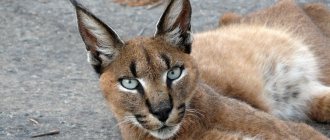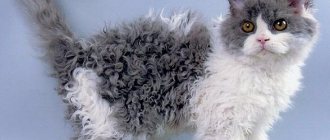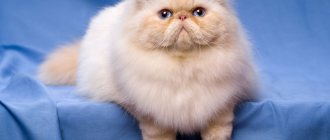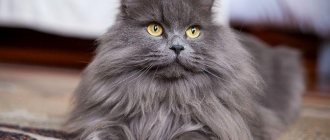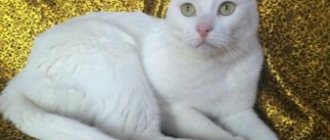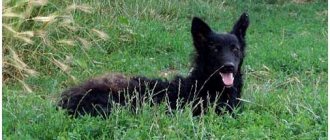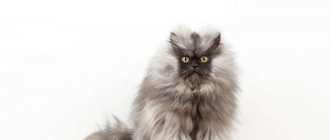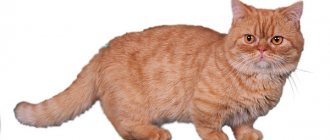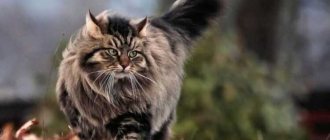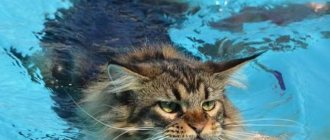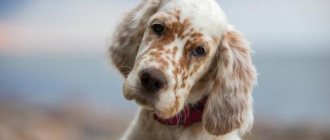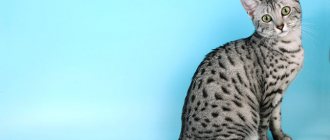The cat family has a huge number of representatives. It has three main subfamilies - small cats, big cats, saber-toothed cats. Unfortunately, the saber-toothed cat species has become extinct. According to genetic lines, cat species are divided into 8 main types:
- Panther line;
- line of Kalimantan cats;
- caracals;
- ocelots;
- lynx;
- cougars;
- Bengal cats;
- domestic cats.
There are many varieties in each group; there are about 250 breeds of domestic cats alone.
Cats that look like a leopard or cheetah
Bengal cat
A small domestic leopard, an intergeneric hybrid of a domestic cat and a wild Bengal cat. Silver cats resemble snow leopards.
Savannah
Miniature cheetah. The athletically graceful cat has large ears and slightly slanted eyes. This is a hybrid of a domestic cat and an African serval.
Safari
Mini leopard. Males can weigh up to 13 kg, and females about 8. The breed is derived from a cross between the Geoffroy wild cat, the shorthaired Siamese and the Bengal cat. The difficulty in the work of felinologists was that a wild cat has 38 chromosomes, and a domestic cat has 36. The hybrid turned out to have 37 chromosomes.
Serengeti
The breed is based on the Bengal cat, Oriental, Abyssinian and tabby cats. The breed is derived entirely from domestic cats.
Egyptian Mau
The oldest breed of cats, which has not changed much over time.
Ocicat
The rare breed was supposed to copy the color of the jungle cat and was obtained by crossing Abyssinian, Siamese and American shorthair cats. He only looks like an ocelot.
Cheeto
Externally, this breed resembles a cheetah, a hybrid of an Ocicat and Bengal cats.
Serval
Servals are wild cats, but there are people who like to keep them at home.
Ocelot
It is quite difficult to keep a “dwarf leopard” at home, but there are nurseries that breed ocelots and servals.
This is interesting: What is the life expectancy of cats at home?
Life of wild forest cats in nature
Forest cats have a wide distribution area and are found in Europe, Africa, along the shores of the Sea of Japan, in the jungles of India, the steppes of Turkestan, the mountains of Scotland and the Caucasus.
You can still find a lot of wild cats in the Scottish mountains
These animals prefer to settle in deep forests, where people rarely visit. Therefore, it is rare to discover the wild ancestors of domestic purrs. Mountain clefts and deserted shores of reservoirs become favorite places for forest cats to live.
These small predators can choose abandoned fox or badger holes, empty tree hollows, and even uninhabited nests of large wading birds as shelter.
The territory occupied by one animal is about 2 hectares in size. Boundaries are marked with the help of odorous anal secretion, with which males carefully irrigate trees and shrubs. An irreconcilable war is waged for each plot, especially during the mating season.
It is also interesting that wild cats do not like areas where there is a lot of snow. After all, under the abundant snow cover, it is difficult for small animals to get food. Therefore, in especially snowy winters, purrs walking on their own can be found near a person’s home. This is how forest cats try to survive, because people always have food.
Peculiarities of behavior of forest cats
Since these representatives of the cat family are wild predators, the cats have a corresponding disposition. Animals love freedom and fiercely defend their independence.
Forest cats are skilled and dexterous hunters
Wild forest cats are loners, leading a secretive lifestyle. The animals quickly and easily evade pursuit, hiding in gorges or on treetops. They lead a nocturnal lifestyle, but do not shy away from hunting in the daytime.
Any small animal that can be caught can serve as prey for forest purrs. These can be rats, nutria, as well as hares or squirrels. A wild cat will not refuse to catch waterfowl, fish, and even crayfish. And in arid regions, insects, snakes and lizards become victims of tailed animals.
The method of attack of forest cats is similar to the hunting methods of other representatives of the species - predators catch prey in a jump, sometimes reaching a length of three to five meters.
To hear even a “word” from a wild forest hunter, you need to greatly anger the animal. And then the animal will make hissing, howling or even whistling sounds. And the meowing typical of cats can only be heard during mating dances and the search for a partner.
Procreation issues
For most of the year, wild forest cats prefer to avoid the company of even their own kind. However, with the onset of cold weather in January, males begin to gather in small groups and look for females for mating until the end of March.
Wild forest cats give birth to up to five kittens in one litter
If two cats develop a liking for the same cat, fights with characteristic fights and warlike cries arise between the furry “knights.”
It also happens that forest males choose domestic females as partners, and then the latter give birth to wild and wayward kittens.
Pregnancy in wild forest cats lasts 62–67 days, after which blind kittens are born. The eyes open only 9–12 days after birth. One litter usually produces five cubs, but there may also be one kitten. Or, on the contrary, the brood turns out to be numerous - up to seven heads.
Shortly before giving birth, the female finds a secluded place from which she makes a safe den. Kittens will grow up in this shelter until they are four months old. The mother cat feeds her cubs with breast milk for the same amount of time.
The level of safety decreases when the grown offspring begins to leave the den on their own - at one and a half to two months of age. And then martens and foxes will pose a threat to the life of the young animals.
At two months, young forest seals begin to go hunting, accompanied by a cat, and at five months they enter adulthood. Males begin to explore new lands, while females remain in the maternal area.
Forest purrs live for quite a long time - up to 15 years. However, young animals often die before reaching 10 years of age.
And if there are no threats in the form of large predators, then life expectancy increases up to 30 years of age. Such situations arise, among other things, when animals enter a person’s home.
Video: forest cat family
Pixie bob
To develop a breed of cat that resembles a lynx, breeders used short-tailed forest cats. These animals live in the forests of North America. The first cat obtained in this way was named Pixie, which means “Elf” or “Fairy” in English.
The animals are distinguished by a short tail, tufts on the ears and whiskers are possible. Pixies are unpretentious, train well and easily make contact with people.
California shining cat
The famous screenwriter Paul Casey was involved in the origin of this breed. On his trip to Africa, he decided to preserve the unique colors of wild cats on the skins of domestic animals.
Many breeds took part in the creation of the new species: Manx, British, Siamese, Angora and Abyssinian cats. Eventually, the Californian shining cat appeared, so named for its unusual color.
The breed immediately found many admirers. They say that the Californian cat is a link between humans and wild nature. At the same time, they do not forget to advertise the new breed everywhere.
Character and behavior
Despite the fact that savannahs look very much like a miniature serval, their character is practically no different from the temperament of domestic pets. Aggression or excessive independence are not typical for this breed.
The main character traits are balance and curiosity, activity and friendliness. It has been observed that kittens obtained from direct crossing of a serval and a domestic cat show greater distrust of strangers. They may hiss at them and avoid contact. Although they behave completely differently with the owners.
It is curious that the behavior of savannahs is more reminiscent of a dog than a cat. Miniature servals prefer active games to hours of sleep. They become very attached to their owners. They are not afraid of water at all. They enjoy frolicking in the pool or bathtub.
Endowed with high intelligence, cats can even be trained. They easily master the “fetch” command. And they happily entertain themselves and their owners by running after a thrown ball or stick. Savannahs love to walk. They are easy to train to a leash and collar.
The breed is not characterized by aggressive behavior. Therefore, Savannah gets along well with other pets, especially dogs. Gets along well with children. But the child must be explained how to behave with the pet. The fact is that the offspring of the first level do not like stroking too much.
The only thing you should think about before buying a savannah is whether you can pay enough attention to it. This breed requires constant human contact. In his absence, cats begin to feel very sad. Savannah is even recommended to buy for families who spend a lot of time at home.
Cats that look like pumas
Abyssinians
A recreated ancient breed based on the indigenous breeds of Africa and Asia.
Chausie
The cat weighs about 10 kg, it is somewhat similar to a chito, but it is the result of crossing a wild jungle cat (swamp lynx) and an Abyssinian cat. Undoubtedly, it resembles a mountain lion - a puma.
Features of feeding
Small kittens are fed up to 6 times a day. The older the animal gets, the less frequent feeding becomes.
You should not introduce chicken as the first meat dish, as its poor quality may harm the kitten’s health. It is better to use a quality product.
In total, the diet should contain not only meat dishes, but also vegetable, fermented milk, and cereals.
The price for a jungle cat can reach $5,000, and even starts at $2,000.Cats that look like lynx
Pikibob
Breeders used North American short-tailed forest cats to create a small version of the lynx.
Kurilian Bobtail
What makes this breed look like a lynx is its short tail and tufts on its ears.
Maine Coon
Giant cats with tufted ears. The shape of the head is very similar to that of a lynx.
Norwegian forest
Powerful bones, wild cat muscles and tufted ears.
Caracal
The desert lynx is a wild cat that is bred in nurseries for domestic keeping.
Caraquet
A fairly new cross between the caracal and the domestic cat that is gaining popularity. Such a cat can weigh up to 15 kg.
This is interesting: TOP 10 medium-sized dog breeds - list, names, weight, photos and descriptions
Lynx (caracal) – a pet for those with character
Most of us are accustomed to thinking of the lynx as a wild animal. However, despite its temperament, this large cat can easily live at home. True, it will not be possible to tame an adult, so the best option is a small kitten, which will become a tame pet thanks to the patience and affection of the owner.
Most often, the caracal is chosen for the home - a spectacular beauty native to Africa with black ears and reddish-brown fur. It has a strong build, long legs and green eyes. By its nature, the caracal can hardly be called a domestic cat, since it is very active, loves solitude and, of course, is a real predator at heart.
It is quite difficult to purchase such an animal, since this type of lynx is sold exclusively in nurseries. There is one more point: caracals value a strong character, so an owner without an inner core will not suit him.
Cats that look like a panther
Burma
The American type of this cat breed, unlike the European one, has more color variations.
Bombay cat
To obtain a miniature black panther, Burmese cats were crossed with black American Shorthairs.
Havana brown
The result of crossing Siamese, regular black and oriental cats. Chocolate panther, with a narrow muzzle and large ears.
Mandalay
The New Zealand Little Panther was created by crossing a Burmese cat and a regular black cat. Later, Abyssinian cats were added to the breed.
TOP 10 most expensive domestic cats
The cats below are united by their lack of close relationship with wild felids. Thanks to this, they all have a friendly character and quickly become attached to a person.
Khao-mani (up to $8500)
Khao-mani are very rare mustaches from Thailand, notable for two features: snow-white color and blue eyes. In rare cases, heterochromia occurs in these animals. Such individuals are sold even more expensive.
Despite its long history, the breed received an official standard only in 2009. Before this, kao-mani were popular only in their homeland and were practically not exported outside the country.
In addition to their unusual appearance, blue-eyed mustaches are notable for their gullibility and friendliness. They are not afraid of strangers, are patient with children's pranks and do not experience jealousy towards other pets.
American Curl (up to $2000)
The main feature of the American Curl is its curly ears, which develop by 2.5-3 months. Given a rare color (golden chinchilla, chocolate and red van), the cost of animals reaches $3,000.
According to the standard, the inversion angle of the ear cartilage is 90-180°. Based on their coat type, Curls are divided into short-haired and long-haired. In both cases, the animals have almost completely no undercoat.
American Curls are completely devoid of the typical feline arrogance and independence. They love their owners by default, like dogs, and respond positively to tactile contact.
“ More about American Curl
Canadian Sphynx (up to $2000)
The high price of Canadian Sphynx cats is due to their unique appearance - almost complete absence of hair. The standard allows only a small presence of delicate short fluff up to 2 mm long.
When purchasing a Sphynx, it is important to understand that its bare skin does not guarantee hypoallergenicity. Dirt, grease and the protein Fel D1, foreign to humans, quickly settle on it - the main cause of allergies to cats.
Despite the rather difficult care, it is difficult not to fall in love with the Canadian Sphynx. Unlike most "mustaches", he becomes attached not to a place, but to the people living there. All sphinxes are devoid of aggression and love tactile contact. For this reason, they do not hide from strangers during noisy parties, but, on the contrary, try to remain in the center of events.
“ More about the Canadian Sphynx
Elf (up to $2000)
The hairless cat with funny curled ears and cashmere-like skin is the result of crossing an American Curl and a Canadian Sphynx. It appeared in 2006 and is one of the youngest breeds in the world.
The majority of catteries with elves are located in the USA, so on average they ask for at least $1,700 for a kitten. If there are no flaws in the exterior, the price rises to $2000.
INTERESTING!
Due to the small number of representatives, a number of countries allow crossing with the Canadian Sphynx. Kittens from such matings are cheaper, but do not always have curled ears.
Elves are affectionate and loyal pets who love to while away time with their owners. They cannot stand loneliness, get along well with children and quickly find a common language with other animals, including dogs.
Egyptian Mau (up to $2000)
Most Egyptian Mau are sold for $1,500, but for show-class specimens they ask for $2,000 or even more. This price tag is explained by its rarity and peculiarity of origin. Unlike other spotted "whiskers", the Egyptian Mau is an aboriginal cat. Its exterior is created by nature and is practically devoid of human intervention. The latter only worked to secure it.
In addition to the spots, the distinctive features of the Egyptian Mau include a mark in the shape of the Latin letter W, or “scarab”. It is located between the forehead and the back of the head.
Egyptian Mau are loyal and loving pets that tolerate temporary separation from their owner well. Despite their love of games, during lonely hours they sleep peacefully on an elevated surface and do not make a mess.
“ More about the Egyptian Mau
Maine Coon (up to $2000)
Maine Coons are large native cats bred in the American state of Maine. Thanks to living in cold and snowy continental winters, these animals acquired thick long hair, especially thick skin on the ears - and powerful paws with tufts of hair that act as snowshoes.
INTERESTING!
Maine Coons are very fertile. Up to 10 kittens are born in one litter, so these cats are profitable from a business point of view.
The average cost of a breed and show class Maine Coon is $1300-1500. A higher price tag is typical for the classic American species with the marbled tabby color.
“ More about Maine Coon
Russian Blue (up to $2000)
On average, Russian blues cost $1300-1400. They are valued for their noble colors and aristocratic character. They have fans all over the world, so if they have a good pedigree, animals are sold for $2,000.
When interacting with children, Russian Blues show restraint until the last moment and do not let out their claws. If their pranks are too active, they proudly leave the baby alone, giving him the opportunity to reflect on his unworthy behavior.
“ More about Russian Blue
Toyger (up to $2000)
Despite its unusual appearance, the toyger was born thanks to experimental matings of a “Bengal” with ordinary domestic and outbred cats. For this reason, the appearance and character of these “mustaches” are largely the same. The only noticeable difference is the striped coat.
INTERESTING!
The Toyger's favorite toy is a sports wheel, in which they spend most of their free time.
On average, toygers are sold for $1,300, but if they have a good pedigree and show class, the price tag reaches $2,000. These animals appeared in Russia only in 2008, so the number of nurseries involved in breeding them is still small.
Serengeti (up to $2000)
The Serengeti is similar to a small serval, but it was created using exclusively domestic cat breeds. Among them:
- Maine Coons;
- Abyssinian;
- oriental;
- European Shorthair;
- Bengali.
The Serengeti is recognized as an experimental breed. There are no more than a couple of hundred representatives worldwide. The average price for kittens corresponds to Toygers, but for similar reasons it can rise higher.
Serengeti are active and inquisitive pets who love outdoor games. For this reason, breeders recommend keeping them in private homes with the possibility of free walking on the street.
Laperm (up to $2000)
Laperms sell for $1200-1300. First of all, they appreciate their unusual curly fur. Also, they are almost impossible to find in Russia, so taking into account transport costs, their cost reaches $2000.
Wavy lapermas are professional chiropractors. They love to stomp on the laps and backs of their owners, relieving stress and fatigue with their purring. The friendliness of cat cats extends not only to people, but also to other animals. For this reason, they are recommended to be taken into large families.
Abyssinian cat
Due to its unique ticked coat color, the Abyssinian cat is very similar to African wild cats. Ticking is alternating light and dark patches on each hair shaft. In addition to their beautiful fur coat, representatives of this breed stand out for their playfulness, high level of intelligence and energetic nature.
Bombay
If you do not take into account the calm, patient and friendly nature of the Bombay, you might think that he is a miniature copy of the black panther. The breed's exotic appearance was achieved by crossing a sable Burmese cat with a black American Shorthair, earning it the nickname "the patent leather baby with the new penny eyes."
Egyptian Mau
Egyptian Mau cats can run at speeds of up to 50 km per hour, making it difficult for them to sit still long enough for you to notice their natural spotted coloring and exotic markings around the eyes. Researchers believe the breed originated in Egypt at least 3,000 years ago, and likely descended from African wild cats.
Owner reviews
“My Nika was given to me at the end of the school year. Mom promised that if I finish with straight A's, then the cat is mine. I have never seen such beautiful animals! This is a real beast of prey with an amazing leopard color. I used to think that we had the main dad in our house, but now I know for sure - it’s Nika. Even he cannot resist her pressure. If something doesn't happen as Nika wants, it will be a real nightmare. She bites, scratches, forces you to do what she sees fit. And God forbid, you cannot understand what she wants. Eats exclusively raw meat. She took patronage over our spaniel, considers all his things and toys exclusively hers, and allows him to eat only after a personal “inspection” of the food bowl.” Valeria, Moscow.
***
“My parents told me as a child that a Savannah cat was an unaffordable luxury for the family budget. Now that I have become a successful businessman, I have fulfilled my childhood dream - I bought a cat of this breed. I have always been a cat person, at first there were two lazy Maine Coons, and then, finally, the handsome Savannah, spotted, amazingly graceful Marat. Exotic cat, dear and very proud. He immediately set up a nest for himself, marked the boundaries of the territory, and our struggle for leadership began. I don’t know yet who will win, but I already understand that this breed is very stubborn and willful.” Dmitry, St. Petersburg.
***
“When I go for a walk with my savannah kitten, I always attract everyone’s attention. This is a rare beauty. If not for its small size, it could easily be mistaken for a lynx cub, or a cheetah, or a leopard. And the similarity in character is also obvious. When he’s angry, he’s a wild beast, but if he’s in a good mood, he’s a smart one to look for. She loves attention and activities, although she does not tolerate baby talk. He eats raw meat, and only the finest. It's never boring with him. He either plays favorably with you or persecutes you for sins known to him alone. The kitten’s claws are razor-sharp, and it’s impossible to dodge the scratches; he’s very fast.” Milan, Novosibirsk.
Pantheretta
This black beauty was born almost by accident. One of the litters of Bengal cats once gave birth to a black baby. The little one grew and became more and more like a panther in appearance.
The breeders did not ignore the amazing similarity, and selection work led to the creation of a new breed. Pantheretta cannot be bought: the work of researchers is not yet finished. Cats of this breed are very friendly, distinguished by good health and indescribable elegance.
Safari
One of the largest cat breeds in the world. The body length of the safari is more than a meter, the tail is thick, long and flexible. The thick plush skin requires special care. Safari is a hybrid of a domestic and wild cat.
The following breeds were used for crossing: Geoffroy, Bengals and Siamese cats. Distinctive features: leopard color, well-developed muscles, pronounced cheekbones on the muzzle, the outer corners of the eyes are noticeably raised.
Appearance description
Savannah is the tallest and largest domestic cat. Its height at the withers reaches 60 cm, and its weight is 15 kg. An elongated and strong body with developed muscles is a distinctive feature of the breed. Cats, especially the first and second generation, have a grace that is unique to wild animals.
Another feature is the neck. In the savannah it is quite long. The muzzle is slightly elongated and large, with rounded ears and wide-set eyes.
Powerful and muscular legs are responsible for the cat's strength, speed and endurance. The cat's tail is not very long, but thick and slightly tapered at the bottom. The fur is thick and soft, reminiscent of the color of a wild animal. The breed standard allows the following options:
- brown;
- gold;
- chocolate;
- silver;
- Cinnamon tabby (brindle) – brown with expressive dark stripes.
The average life expectancy is 17–20 years.
Ocicat
With a coat that can be spotted with tan, chocolate, bluish, lavender or tan and cinnamon, the Ocicat is quite an exotic breed. But there is nothing wild about these cats: the breed was the result of crossing Abyssinians, Siamese and American Shorthair cats.
Hausie coat color and texture
Wool changes its structure significantly depending on the season. In summer it becomes tougher and looser. By winter, chausies become pubescent. The coat becomes thicker and softer. The undercoat becomes denser.
Read here Animal cremation.
The color completely matches the color of wild relatives. It can fluctuate a bit, but generally has sandy gray undertones.
Chausies may have a tendency to have a monochromatic coat, or exhibit spotting in the form of black spots and sometimes even stripes.
Savannah
A relatively new breed that was recognized by the Cat Fanciers' Association in 2012, the Savannah is known for its unusual appearance. Large, tall ears are located on the top of the head. The savanna is also characterized by a long neck, long legs and a short, thick tail. In addition, these cats have exotic spotted and striped coats. And this is not surprising, the wild appearance of the savannah was achieved by crossing the African serval with a domestic cat.
Caring for domestic jungle cats
Caring for a Hausi in an apartment or a private home (especially in rural settings) varies significantly.
In urban areas, brushing can only be done during the shedding period, while in rural areas this must be done weekly. The cat even likes to be scratched on the head, back, and neck. You also need to carry out regular treatment against insects.
As for the claws of the Housie, it is highly recommended that owners place several scratching posts. Moreover, choose completely different textures. This will make it more interesting for the animal.
To attract the house's attention to the scratching post and prevent furniture and other utensils from being scratched, you should lubricate them with catnip.
Since the cat is quite large in size, the scratching post needs to be securely attached.
- Where can I take veterinary courses and what are they for?
Akita Inu. What kind of breed is this and what are its characteristics?
Siamese cat - description of the breed, character and features of caring for Siamese cats (105 photos and videos)
If you trim claws, do this after sitting the animal down and calming it down.
Toyger
Thanks to its orange color with black or brown stripes and muscular body, the toyger can easily be confused with a real tiger cub. Fortunately, this breed is much nicer (and safer) to humans than a tiger cub and is known for its sweet, calm and friendly nature. The wild appearance of the Toyger was obtained by crossing a Bengal and a domestic tabby shorthair cat.
Housey
This is a relatively young cat breed that was created by crossing a domestic cat with a wild jungle cat (Felis chaus). They can grow to almost a meter in length and weigh 4-7 kilograms or more. As with other hybrid Savannah or Bengal cats, male Housies from the first few generations are usually sterile, with the F4 and F5 generations considered the most suitable for showing.
Preparing for the arrival of a kitten and care features
If fortune smiled and you managed to buy a kitten, you definitely need to prepare for its appearance in the house. No breeder will sell very small animals. Up to 4 months, the offspring still needs mother's care and breastfeeding.
Typically, future owners of a savannah receive a four-month-old baby who is already strong enough for a change of environment, able to withstand a long journey to a new home, and accustomed to eating and using a litter box on his own.
Like adult animals, Savannah kittens are very active and incredibly jumpy. Therefore, you will have to put away dangerous and valuable things in a safe place. Hiding your favorite souvenirs on the closet is not the best solution. Sooner or later, a curious pet will master new heights and reach all open hiding places.
Owners must take care of the safety of the pet - disguise wires and cables. Get rid of plants that may be poisonous to your cat. It is possible that the kitten will decide to taste everything. Therefore, it is better not to take risks.
Kittens, like all babies, are active and playful. They actively explore the world around them. The owners will constantly have to be on guard so that the inquisitive baby does not get into trouble.
The diet of kittens is slightly different from that of an adult animal. It is better to find out the feeding characteristics of each specific pet from the breeder. Usually kittens already eat on their own and are accustomed to complementary foods - mousses or jelly.
When feeding natural products, the diet should include meat, finely chopped or in the form of minced meat. Under no circumstances should kittens be given cow's or goat's milk. It is too fatty and causes stomach upsets.
Savannahs are rare and expensive, but unique cats. They have an unusual appearance, amazing character and well-developed intelligence. They are graceful, agile and fast. Affectionate and gentle with their owners, and very strict with strangers.
Serengeti
The goal of breeding the Serengeti breed was to create a cat that resembled the wild Serval, but did not contain any of its ancestry. The first Serengeti was created by Karen Sauzman in 1994 by crossing a Bengal and an Oriental cat. Subsequent offspring were crossed with many other types of cats to perfect the breed. However, the Serengeti ancestry includes genes from the wild Bengal cat, which was used to create the domestic Bengal cat. Cats of this breed have long ears and legs, like a serval. They are very mobile, active, and sociable.
Didn't find what you were looking for? Use the site search form
Diseases
Due to the fact that there are wild cats in the Hausi family, this has contributed to the fact that they are not prone to diseases. They have excellent health.
But kittens should still receive the necessary vaccinations against herpesvirus infections, calicivirus and other infections.
You should also regularly do deworming 1 or 2 times a year.
